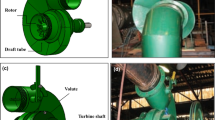Abstract
Nowadays, developments in the field of combined power units represent an urgent task for energy supply to consumers. One of the promising directions in this field consists in the development of engineering solutions based on low head pressure (ΔZ ≤ 20 m) microhydroelectric power plants with a siphon penstock, using the terrain features, natural reservoirs with height differences, and a ready industrial infrastructure. One of the specific problems of such combined power units consists in the operation of hydraulic turbines at variable head pressure, which leads to inconsistencies in the generation of electrical energy and a significant idle time in the hydraulic unit’s operation. In this paper, possible solutions to this problem are considered that are associated with the use of hydraulic turbines having an aperiodic blade system designed for the entire design domain of feeds Q and heads H determined from the conditions of joint operation of the hydraulic system–hydraulic turbine complex at different ΔZ. To carry out parametric studies, a design model for the hydraulic part of the cogeneration system has been developed, including a fragment of a siphon penstock and a hydraulic turbine. Studies on the grid viscosity and calculation and experimental verification of the model have been performed and optimal settings for the grid generator and the number of cells have been established: nel = 1 300 000 elements. The optimal settings have been obtained based on achieving an averaged value in calculated and experimental hydroturbine power δN accurate within ±5%. The numerical simulation of several variants for hydraulic turbines with different blade systems designed taking into account the experience of developing aperiodic blade systems in the field of pump engineering has been performed. In particular, such factors affecting the turbine efficiency as the pitch of the blade system at the inlet, outlet, and at the center of the skeletal lines of the blades, as well as the order of the blade arrangement in the aperiodic blade system, have been considered. A comparative analysis of hydraulic turbines with classical and aperiodic blade systems has been performed. It has been established that designing a bladed system of a hydraulic turbine in the design domain makes it possible to increase the efficiency of microHPP operation by 5.5% as well as to extend the range of efficient operation in the feed and head by 21.2 and 7.3%, respectively. At the same time, it should be noted that a low sensitivity of the main target parameter (efficiency of microHPP) with respect to the factors revealed in the course of the study is observed. Based on this, further prospects for the development of this study consist in the development of a parametric design model for a hydraulic turbine with the aperiodic blade system and a series of calculations using the theory of experimental design or stochastic methods for multidimensional optimization.







Similar content being viewed by others
REFERENCES
R. A. Amerkhanov, A. S. Kirichenko, R. S. Kas’yanov, V. S. Kostenko, A. A. Kulichkina, A. A. Skorokhod, E. G. Armaganyan, and V. V. Dvornyi, “Possibilities of use of renewable sources of energy of Krasnodar region,” Al’tern. Energ. Ekol., No. 13–14, 13–25 (2015).
E. M. Malaya, D. V. Romagina, and N. S. Egorova, “Cogeneration plants,” Resursoenergoeff. Tekhnol. Stroit. Komplekse Reg., No. 4, 151–154 (2014).
A. I. Rudakov and I. B. Nuriakhmetov, “Classification and design features of mini hydroelectric power plants for small consumers,” in Topical Issues of Modern Research (Proc. 15th Int. Sci.-Tech. Conf., Omsk, Russia, Sept. 26,2018) (Mir Nauki, 2018), pp. 83–90.
A. F. Makarov and A. G. Arzamasova, “Development of a power supply system for treatment plants using mini hydroelectric power plants,” in Science and Innovation in Modern Conditions (Proc. Int. Sci.-Pract. Conf., Magnitogorsk, Russia, Mar. 8,2016) (Omega Sains, Magnitogorsk, 2016), Vol. 3, pp. 97–99.
D. A. Legkii and E. A. Denisenko, “Design and operating features of micro and mini hydroelectric power plants,” in Scientific Support of the Agro-Industrial Complex (Proc. All-Russian Conf., Krasnodar, Russia, Apr. 26,2019) (Kuban. Gos. Agrar. Univ. im. I. T. Trubilina, Krasnodar, 2019), pp. 983–985.
A. A. Popov, “Selection of the type of hydraulic turbines for a derivational hydroelectric power plant under Amur region’s conditions,” in Problems and Prospects of the Development of the Agro-Industrial Complex of Russia (Proc. Conf., Blagoveshchensk, Russia, Apr. 19,2017) (Dal’nevost. Gos. Agrar. Univ., Blagoveshchensk, 2017), pp. 23–25.
D. V. Nozhenko and T. K. Erasova, “Analysis of the use of turbine installations,” in Problems and Prospects of the Development of Russia: Youth’s Look into the Future (Proc. Conf., Kursk, Russia, Oct. 17–18,2018) (Yugo-Zapadn. Gos. Univ, Kursk, 2018), Vol. 3, pp. 287–289.
B. V. Lukutin, S. G. Obukhov, and E. B. Shandarova, Autonomous Power Supply from Mini Hydroelectric Power Plants (Tomsk. Politekh. Univ., Tomsk, 2001) [in Russian].
A. A. Zharkovskii and A. Y. Pospelov, “Use of 3D methods for flow analysis, prediction of characteristics, and optimization of the shape of settings of hydraulic turbines,” Power Technol. Eng. 49, 27–32 (2015). https://doi.org/10.1007/s10749-015-0568-4
A. Y. Pospelov and A. A. Zharkovskii, “Effect of the parameters of a computational model on the prediction of hydraulic turbine characteristics,” Power Technol. Eng. 49, 159–164 (2015). https://doi.org/10.1007/s10749-015-0591-5
P. V. Pugachev, D. G. Svoboda, and A. A. Zharkovskii, Calculation and Design of Blade Hydraulic Machines. Calculation of Viscous Flow in Blade Hydraulic Machines Using the ANSYS CFX Package (S.-Peterb. Politekh. Univ., St. Petersburg, 2016) [in Russian].
Funding
This work was financially supported by the Ministry of Science and Higher Education of the Russian Federation (unique project identification number RFMEFI58618X0060) and the Ministry of Education, Youth, and Sports of the Czech Republic (unique project identification number LTARF18).
Author information
Authors and Affiliations
Corresponding authors
Additional information
Translated by O. Polyakov
Rights and permissions
About this article
Cite this article
Vikhlyantsev, A.A., Volkov, A.V., Ryzhenkov, A.V. et al. Increasing Efficiency for MicroHPP Hydroturbines Operating under Variable Head Pressure Using an Aperiodic Blade System. Therm. Eng. 67, 922–930 (2020). https://doi.org/10.1134/S0040601520120149
Received:
Revised:
Accepted:
Published:
Issue Date:
DOI: https://doi.org/10.1134/S0040601520120149




